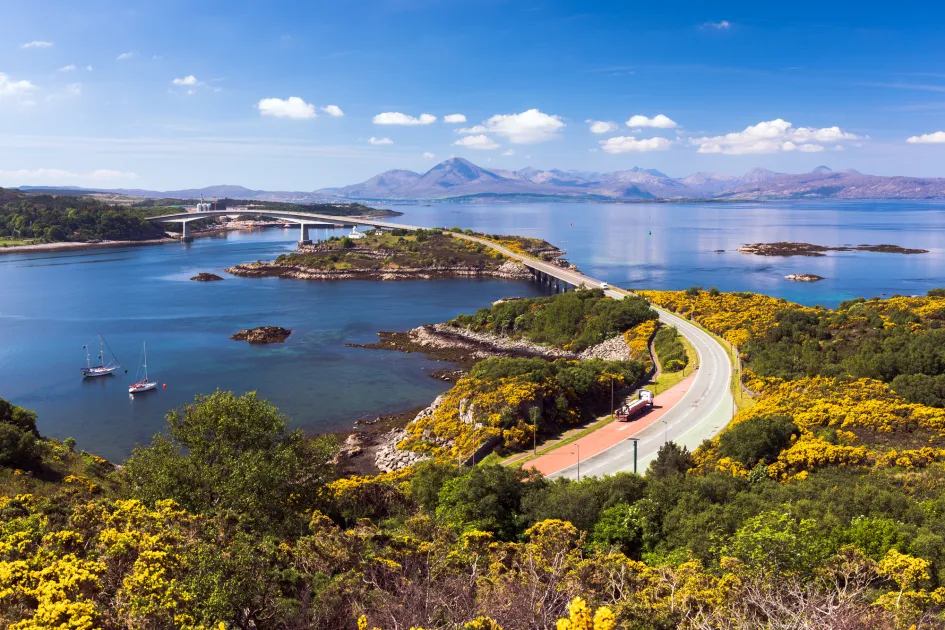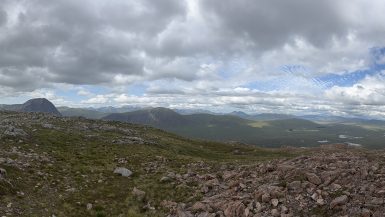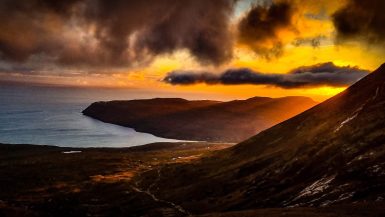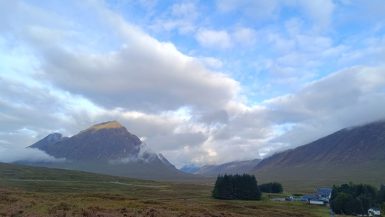Kyle of Lochalsh: Gateway to Skye and Heart of the Highlands
In August 2019, I arrived in Kyle of Lochalsh, a charming village nestled on the mainland side of the Skye Bridge, and immediately felt the pull of its history, scenery, and quiet resilience. Often seen as a stepping stone to the Isle of Skye, Kyle is much more than a transit point—it’s a community with deep roots, surrounded by landscapes that have shaped Highland life for centuries.
🏞️ Where Land Meets Sea: The Setting of Kyle
Kyle of Lochalsh sits at the meeting point of Loch Alsh and the Inner Sound, with views stretching across to the Isle of Skye and the jagged peaks of the Cuillin mountains. The name “Kyle” comes from the Gaelic Caol Loch Aillse, meaning “strait of the foaming loch,” a nod to the turbulent waters that once separated the mainland from Skye before the bridge was built.
The village is framed by wooded hills, tidal inlets, and dramatic coastlines. It’s a place where the sea is never far away, and the rhythm of life is shaped by the tides, the weather, and the steady hum of ferryboats and fishing vessels.
🌉 The Skye Bridge: A Modern Link with Ancient Meaning
Before 1995, Kyle of Lochalsh was the main ferry terminal for travelers heading to Skye. The ferry crossing to Kyleakin was a rite of passage for generations of visitors. With the opening of the Skye Bridge, the journey became faster and more accessible, but the bridge itself became a symbol of change—and controversy.
Initially a toll bridge, it sparked protests and campaigns from locals who saw the fees as unfair. After years of activism, the tolls were abolished in 2004, and the bridge now stands as a free and vital link between Skye and the mainland.
The bridge’s elegant arc complements the natural beauty of the area, and walking or driving across it offers panoramic views of the surrounding lochs and mountains.
🛤️ A Railway Town with a Highland Soul
Kyle of Lochalsh owes much of its development to the railway. In 1897, the extension of the Highland Railway from Inverness to Kyle transformed the village into a bustling port and transport hub. The station, still in operation today, is one of the most scenic termini in Britain, with trains winding through glens, past lochs, and over viaducts before arriving at the sea.
The railway brought commerce, tourism, and connection to remote Highland communities. Goods were shipped from Kyle to the Hebrides, and the village became a lifeline for islanders and mainlanders alike.
Today, the station retains its charm, and the journey from Inverness to Kyle is considered one of the most beautiful rail routes in the UK.
🏘️ The Community: Heritage and Hospitality
Kyle of Lochalsh is home to around 650 residents, many of whom are involved in tourism, fishing, and local services. The village has a strong sense of community, with shops, cafés, and pubs that offer warm Highland hospitality.
The Kyle Hotel and Lochalsh Hotel are historic establishments that have welcomed travelers for generations. The village also hosts art galleries, craft shops, and the Kyle Community Hall, which serves as a hub for events, ceilidhs, and gatherings.
Nearby, the village of Plockton—just a 10-minute drive northeast—is often called “the jewel of the Highlands.” With its palm trees (thanks to the Gulf Stream), whitewashed cottages, and sheltered bay, Plockton is a favorite for artists, sailors, and visitors seeking tranquility.
To the south lies Dornie, home to the iconic Eilean Donan Castle, and to the east, the village of Balmacara, surrounded by woodland trails and crofting landscapes managed by the National Trust for Scotland.
🛡️ Historical Significance and Clan Connections
The area around Kyle of Lochalsh has long been a crossroads of clan history. Lochalsh was once part of the lands held by Clan Mackenzie, one of the most powerful clans in the Highlands. The Mackenzies were known for their strategic marriages, political influence, and military prowess.
Clan Macrae, closely allied with the Mackenzies, served as hereditary constables of Eilean Donan Castle and played a key role in defending the region during the Jacobite uprisings. Their legacy is still felt in the area, with clan gatherings and historical markers commemorating their contributions.
The surrounding glens and lochs were also affected by the Highland Clearances, when many families were evicted to make way for sheep farming. The scars of these clearances remain in the landscape and in the stories passed down through generations.
🚶 Exploring the Area: Nature and Culture
Kyle of Lochalsh is a perfect base for exploring the natural and cultural riches of the Highlands and Skye. Popular activities include:
- Walking the Plock: A scenic hill above the village offering views of the bridge and Skye.
- Visiting Eilean Donan Castle: Just 15 minutes away, this restored fortress is one of Scotland’s most photographed landmarks.
- Exploring Balmacara Estate: Managed by the National Trust, it offers trails through native woodland and crofting landscapes.
- Boat trips and wildlife tours: The waters around Kyle are rich in marine life, including seals, dolphins, and seabirds.
Final Thoughts
Kyle of Lochalsh is more than a gateway—it’s a destination in its own right. With its rich history, welcoming community, and stunning surroundings, it offers a glimpse into the heart of the Highlands. Whether you’re crossing the bridge to Skye, arriving by train from Inverness, or simply pausing to take in the view, Kyle invites you to slow down, listen to the land, and become part of its story.
In August 2019, as I watched the sun dip behind the Cuillin and the tide roll in beneath the bridge, I felt the timeless pull of this place. Kyle of Lochalsh isn’t just where journeys begin—it’s where they linger.
Sources:
- VisitScotland: Kyle of Lochalsh
- National Trust for Scotland: Balmacara Estate
- Historic Environment Scotland: Eilean Donan Castle
- Undiscovered Scotland: Plockton and Lochalsh History




Leave a reply
You must be logged in to post a comment.